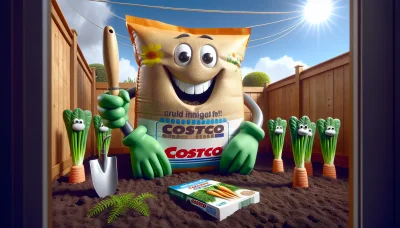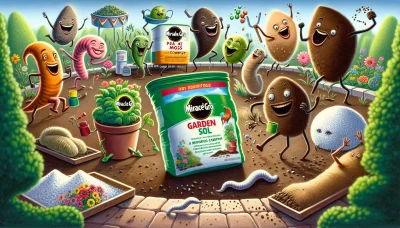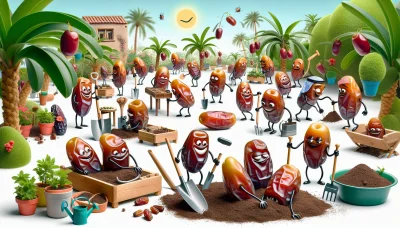How to eat guavas Quiz
Test Your Knowledge
Question of
How to Eat Guavas: A Gardener's Delight
There's a unique joy that comes with growing your own guavas and enjoying the fruits of your labor directly from the garden. The experience of plucking a ripe, fragrant guava from its branch and biting into its sweet, juicy flesh is incomparable. Growing guavas not only adds a lush, tropical feel to your garden but also provides you with a delicious, nutritious snack that's packed with vitamins and antioxidants. Let's dive into the world of guavas and discover the pleasures of consuming this exotic fruit fresh from the tree.
Choosing the Right Guavas
Selecting the best guavas for eating involves a few key factors including ripeness, color, and variety. A ripe guava should yield slightly under gentle pressure, similar to an avocado. The color can vary widely depending on the variety, ranging from green to yellow or even a pink hue. However, a change in color often indicates ripeness, with many varieties transitioning from bright green to a more yellow or light green as they ripen. The variety of guava also plays a significant role in choosing the right fruit for your palate; some are sweeter, while others offer a more tart or even slightly bitter flavor. Experimenting with different types can help you find your personal preference for both fresh eating and culinary uses.
Preparation and Cleaning
To properly wash and prepare guavas before eating, start by gently rinsing them under cold running water to remove any surface dirt or pesticides. It's not necessary to use soap, but you can opt for a produce wash if desired. After rinsing, dry the guavas with a clean cloth or paper towel. If you're planning to eat the skin, which is rich in nutrients, ensure it's thoroughly cleaned. Some people prefer to peel the guava, especially if the skin is too rough or if the guava is not organically grown. To eat, you can either cut the guava into slices or bite directly into it, like an apple. Be mindful of the seeds, as they are hard and can be difficult to chew. You can eat them, but it's often more comfortable to spit them out. For recipes requiring guava without seeds, cut the fruit in half and scoop out the seeds before using the flesh in your dish.
Different Ways to Enjoy Guavas
- Eating them raw
- Making guava juice
- Incorporating them into recipes
- Creating guava jam or jelly
- Preparing guava smoothies
- Using them in salads
- Baking them into desserts like cakes and tarts
- Making guava sauce for meats
- Freezing them for a cold treat
- Drying them for a chewy snack
The Health Benefits of Guavas
Guavas are a tropical fruit that are not only delicious but also packed with a variety of essential nutrients that contribute to overall health. Rich in dietary fiber, guavas are excellent for improving digestive health and can aid in weight loss by making you feel full longer. They are an outstanding source of vitamin C, providing more than twice the daily recommended intake in just one fruit, which is crucial for immune system function and skin health. Guavas also contain vitamin A, which is important for eye health, and potassium, which helps in regulating blood pressure levels. Additionally, the antioxidants present in guavas, such as lycopene and beta-carotene, play a role in cancer prevention and the reduction of inflammation. Incorporating guavas into your diet can offer a wide range of health benefits, from enhancing heart health to providing a boost to your immune system.
Growing Your Own Guavas
Guava trees are a tropical delight that, with the right conditions, can be grown in your own garden. These trees thrive in warm climates but are surprisingly hardy and can tolerate a brief spell of colder temperatures, though they cannot withstand frost. Ideally, guava trees prefer a location that receives full sunlight, ensuring they receive ample warmth and light throughout the day. When it comes to soil, guavas are not overly fussy, but they do best in well-draining soil that is rich in organic matter. Regular watering is crucial, especially during the warmer months, to keep the soil consistently moist but not waterlogged. Guavas also benefit from regular applications of fertilizer to support their vigorous growth and fruit production. With the right care, guava trees can not only add a tropical flair to your garden but also provide you with a delicious and nutritious fruit harvest.
Guava Recipes for Gardeners
| Recipe Name | Ingredients | Preparation Steps |
|---|---|---|
| Guava Smoothie | Guavas, banana, honey, milk, ice cubes | Blend all ingredients until smooth. |
| Guava BBQ Sauce | Guava paste, vinegar, tomato paste, garlic, onion, spices | Mix ingredients and simmer for 30 minutes. |
| Guava Cheesecake | Cream cheese, guava paste, sugar, eggs, crust ingredients | Blend filling, pour into crust, and bake for 45 minutes at 350°F. |












